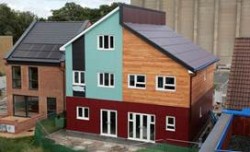A new type of factory-built, modular home that can be built in half the time as an ordinary house has made its debut in the UK, with promoters saying it could help ease the country’s housing shortage.
Dubbed “the ultimate in super-efficient, factory-finished, configurable dwellings”, the homes cost less than $1,540 (£1,000) per square metre to build and can be ready to live in after eight weeks, compared to the average build-time of 16 weeks for a UK house, says building research firm BRE, which this week opened two demonstration units at its BRE Innovation Park in Watford, England.
One of the units has a building-integrated photovoltaic roof.
“We have a chronic shortage of housing in the UK – we need to deliver 250,000 homes a year to meet market demand – last year we managed 118,000, less than half,” said Director of the BRE Innovation Park, Dr David Kelly, adding: “This approach could really help us make significant progress with volume delivery.”
The system has been developed by a Swiss technology non-profit, Üserhuus AG, and a Scottish developer of prefabricated, energy-efficient housing, Tigh Grian Ltd.
The concept has already been commissioned for use on a 50-unit housing development in Scotland, BRE said.
The system is based on volumetric units that can be configured into a single-bedroom apartment or a combination of units forming houses of up to four or five bedrooms.
Manufactured in Wales using a structural insulated panel system (SIPs), the 4.9m x 11.4m modules can be assembled into units of up to five storeys in various configurations.
Each unit leaves the factory fully serviced, fitted out and decorated, to be laid on pre-prepared foundations.
With EPC B ratings, each unit is fully insulated and heated using a whole house mechanical heat recovery ventilation system, with wall-mounted electric panel heaters.
The basic house types aim to deliver low annual energy bills estimated at £300 to £500 a year.
“The future of architectural design lies with the integration of renewable energy technologies,” said Dr. Stephen Wittkopf, managing director of Üserhuus AG.
“The project on the BRE Innovation Park is showcasing a first-in-the-UK integrated, terracotta style cladding and roofing PV system which points the way for future housing – we are looking forward to seeing how it performs and we want to test other technologies.”
BRE Innovation Park was set up in 2005 to test and demonstrate low- and zero-carbon buildings of the future.
For more information and to see the units, click here.
Original link - Global Construction Review
New modular home system touted to ease UK housing shortage
23rd September, 2015









